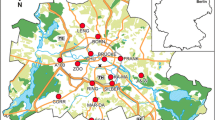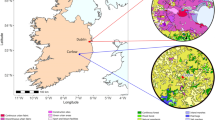Abstract
Although grass pollen is widely regarded as the major outdoor aeroallergen source in Australia and New Zealand (NZ), no assemblage of airborne pollen data for the region has been previously compiled. Grass pollen count data collected at 14 urban sites in Australia and NZ over periods ranging from 1 to 17 years were acquired, assembled and compared, revealing considerable spatiotemporal variability. Although direct comparison between these data is problematic due to methodological differences between monitoring sites, the following patterns are apparent. Grass pollen seasons tended to have more than one peak from tropics to latitudes of 37°S and single peaks at sites south of this latitude. A longer grass pollen season was therefore found at sites below 37°S, driven by later seasonal end dates for grass growth and flowering. Daily pollen counts increased with latitude; subtropical regions had seasons of both high intensity and long duration. At higher latitude sites, the single springtime grass pollen peak is potentially due to a cooler growing season and a predominance of pollen from C3 grasses. The multiple peaks at lower latitude sites may be due to a warmer season and the predominance of pollen from C4 grasses. Prevalence and duration of seasonal allergies may reflect the differing pollen seasons across Australia and NZ. It must be emphasized that these findings are tentative due to limitations in the available data, reinforcing the need to implement standardized pollen-monitoring methods across Australasia. Furthermore, spatiotemporal differences in grass pollen counts indicate that local, current, standardized pollen monitoring would assist with the management of pollen allergen exposure for patients at risk of allergic rhinitis and asthma.





Similar content being viewed by others
References
American Academy of Allergy, Asthma & Immunology. (2015). Counting stations. http://www.aaaai.org/global/nab-pollen-counts/counting-stations.aspx. Accessed 15 Jul 2015.
Andersson, K., & Lidholm, J. (2003). Characteristics and immunobiology of grass pollen allergens. International Archives of Allergy and Immunology, 130(2), 87–107.
Australasian Society of Clinical Immunology and Allergy. (2014). Pollen calendar–guide to common allergenic pollen. http://www.allergy.org.au/patients/allergic-rhinitis-hay-fever-and-sinusitis/guide-to-common-allergenic-pollen. Accessed 05 Apr 2014.
Bass, D. J., Delpech, V., Beard, J., Bass, P., & Walls, R. S. (2000). Late summer and fall (March–May) pollen allergy and respiratory disease in Northern New South Wales, Australia. Annals of Allergy, Asthma & Immunology, 85(5), 374–381.
Beggs, P. J., Katelaris, C. H., Medek, D., Johnston, F. H., Burton, P. K., Campbell, B., et al. (2015). Differences in grass pollen allergen exposure across Australia. Australian and New Zealand Journal of Public Health, 39(1), 51–55.
Bousquet, P.-J., Hooper, R., Kogevinas, M., Jarvis, D., & Burney, P. (2007). Number of allergens to be tested to assess allergenic sensitization in epidemiologic studies: Results of the European Community Respiratory Health Survey I. Clinical and Experimental Allergy, 37(5), 780–787.
Buters, J. T. M., Weichenmeier, I., Ochs, S., Pusch, G., Kreyling, W., Boere, A. J. F., et al. (2010). The allergen Bet v 1 in fractions of ambient air deviates from birch pollen counts. Allergy, 65(7), 850–858.
Collatz, G. J., Berry, J. A., & Clark, J. S. (1998). Effects of climate and atmospheric CO2 partial pressure on the global distribution of C4 grasses: Present, past, and future. Oecologia, 114(4), 441–454.
Dass, D. (2010). Influence of weather on prevalence and seasonality of airspora in Canberra. Honours Thesis, The Australian National University.
Davies, J. M. (2014). The contribution of subtropical grass pollen allergens to the global burden of allergic respiratory disease. Clinical and Experimental Allergy, 44(6), 790–801.
Davies, J. M., Dang, T. D., Voskamp, A., Drew, A. C., Biondo, M., Phung, M., et al. (2011). Functional immunoglobulin E cross-reactivity between Pas n 1 of Bahia grass pollen and other group 1 grass pollen allergens. Clinical and Experimental Allergy, 41(2), 281–291.
Davies, J. M., Li, H., Green, M., Towers, M., & Upham, J. W. (2012). Subtropical grass pollen allergens are important for allergic respiratory diseases in subtropical regions. Clinical and Translational Allergy, 2(4), 1–10.
de Morton, J., Bye, J., Pezza, A., & Newbigin, E. (2011). On the causes of variability in amounts of airborne grass pollen in Melbourne, Australia. International Journal of Biometeorology, 55(4), 613–622.
de Weger, L. A., Beerthuizen, T., Gast-Strookman, J. M., van der Plas, D. T., Terreehorst, I., Hiemstra, P. S., & Sont, J. K. (2011). Difference in symptom severity between early and late grass pollen season in patients with seasonal allergic rhinitis. Clinical and Translational Allergy, 1(1), 1–11.
Ehleringer, J. R., Cerling, T. E., & Helliker, B. R. (1997). C4 photosynthesis, atmospheric CO2, and climate. Oecologia, 112(3), 285–299.
Erbas, B., Akram, M., Dharmage, S. C., Tham, R., Dennekamp, M., Newbigin, E., et al. (2012). The role of seasonal grass pollen on childhood asthma emergency department presentations. Clinical and Experimental Allergy, 42(5), 799–805.
Erbas, B., Chang, J.-H., Dharmage, S., Ong, E. K., Hyndman, R., Newbigin, E., & Abramson, M. (2007a). Do levels of airborne grass pollen influence asthma hospital admissions? Clinical and Experimental Allergy, 37(11), 1641–1647.
Erbas, B., Chang, J.-H., Newbigin, E., & Dhamarge, S. (2007b). Modelling atmospheric concentrations of grass pollen using meteorological variables in Melbourne, Australia. International Journal of Environmental Health Research, 17(5), 361–368.
Ford, S. A., & Baldo, B. A. (1986). A re-examination of ryegrass (Lolium perenne) pollen allergens. International Archives of Allergy and Immunology, 81(3), 193–203.
Frenguelli, G., Passalacqua, G., Bonini, S., Fiocchi, A., Incorvaia, C., Marcucci, F., et al. (2010). Bridging allergologic and botanical knowledge in seasonal allergy: A role for phenology. Annals of Allergy, Asthma & Immunology, 105(3), 223–227.
Galán, C., Antunes, C., Brandao, R., Torres, C., Garcia-Mozo, H., Caeiro, E., et al. (2013). Airborne olive pollen counts are not representative of exposure to the major olive allergen Ole e 1. Allergy, 68(6), 809–812.
Galán, C., Emberlin, J., Domínguez, E., Bryant, R. H., & Villamandos, F. (1995). A comparative analysis of daily variations in the Gramineae pollen counts at Córdoba, Spain and London, UK. Grana, 34(3), 189–198.
Galán, C., Smith, M., Thibaudon, M., Frenguelli, G., Oteros, J., Gehrig, R., et al. (2014). Pollen monitoring: minimum requirements and reproducibility of analysis. Aerobiologia, 30(4), 385–395.
Green, B. J., Dettmann, M. E., Rutherford, S., & Simpson, R. W. (2002). Airborne pollen of Brisbane, Australia: A five-year record, 1994–1999. Grana, 41(4), 242–250.
Green, B. J., Dettmann, M., Yli-Panula, E., Rutherford, S., & Simpson, R. (2004). Atmospheric Poaceae pollen frequencies and associations with meteorological parameters in Brisbane, Australia: A 5-year record, 1994–1999. International Journal of Biometeorology, 48(4), 172–178.
Haberle, S. G., Bowman, D. M. J. S., Newnham, R. M., Johnston, F. H., Beggs, P. J., Buters, J., et al. (2014). The macroecology of airborne pollen in Australian and New Zealand urban areas. PLoS ONE, 9(5), e97925. doi:10.1371/journal.pone.0097925.
Hattersley, P. W. (1983). The distribution of C3 and C4 grasses in Australia in relation to climate. Oecologia, 57(1–2), 113–128.
Hill, D. J., Smart, I. J., & Knox, R. B. (1979). Childhood asthma and grass pollen aerobiology in Melbourne. The Medical Journal of Australia, 1(10), 426–429.
IPCC. (2013). Climate Change 2013: The Physical Science Basis: Working Group I Contribution to the Fifth Assessment Report of the Intergovernmental Panel on Climate Change. Cambridge: Cambridge University Press.
Johansen, N., Weber, R. W., Ipsen, H., Barber, D., Broge, L., & Hejl, C. (2009). Extensive IgE cross-reactivity towards the Pooideae grasses substantiated for a large number of grass-pollen-sensitized subjects. International Archives of Allergy and Immunology, 150(4), 325–334.
Johnston, F. H., Hanigan, I. C., & Bowman, D. M. J. S. (2009). Pollen loads and allergic rhinitis in Darwin, Australia: A potential health outcome of the grass-fire cycle. EcoHealth, 6(1), 99–108.
Katelaris, C. H. (2000). Allergic rhinoconjunctivitis—An overview. Acta Ophthalmologica Scandinavica, 78(s230), 66–68.
Katelaris, C. H., & Burke, T. V. (2003). A 7 year pollen profile of major Olympic Games venues in Sydney, Australia. Aerobiologia, 19(2), 121–124.
Kosisky, S. E., Marks, M. S., & Nelson, M. R. (2010). Pollen aeroallergens in the Washington, DC, metropolitan area: A 10-year volumetric survey (1998–2007). Annals of Allergy, Asthma & Immunology, 104(3), 223–235.
McMaster, G. S., & Wilhelm, W. W. (1997). Growing degree-days: One equation, two interpretations. Agricultural and Forest Meteorology, 87(4), 291–300.
Murphy, B. P., & Bowman, D. M. J. S. (2007). Seasonal water availability predicts the relative abundance of C3 and C4 grasses in Australia. Global Ecology and Biogeography, 16(2), 160–169.
Newnham, R. M. (1999). Monitoring biogeographical response to climate change: The potential role of aeropalynology. Aerobiologia, 15(2), 87–94.
Newnham, R. M., Fountain, D. W., Cornford, C. C., & Forde, M. B. (1995). A national survey of airborne pollen and grass flowering in New Zealand, with implications for respiratory disorder. Aerobiologia, 11(4), 239–252.
Nony, E., Timbrell, V., Hrabina, M., Boutron, M., Solley, G., Moingeon, P., & Davies, J. M. (2015). Specific IgE recognition of pollen allergens from subtropic grasses in patients from the subtropics. Annals of Allergy, Asthma & Immunology, 114, 214e220.
Peel, R. G., Kennedy, R., Smith, M., & Hertel, O. (2014). Relative efficiencies of the Burkard 7-day, Rotorod and Burkard Personal samplers for Poaceae and Urticaceae pollen under field conditions. Annals of Agricultural and Environmental Medicine, 21(4), 745–752.
Schäppi, G. F., Taylor, P. E., Pain, M. C. F., Cameron, P. A., Dent, A. W., Staff, I. A., & Suphioglu, C. (1999). Concentrations of major grass group 5 allergens in pollen grains and atmospheric particles: Implications for hay fever and allergic asthma sufferers sensitized to grass pollen allergens. Clinical and Experimental Allergy, 29(5), 633–641.
Stevenson, J., Haberle, S. G., Johnston, F. H., & Bowman, D. M. J. S. (2007). Seasonal distribution of pollen in the atmosphere of Darwin, tropical Australia: Preliminary results. Grana, 46(1), 34–42.
Sturman, A. P., & Tapper, N. J. (2006). The weather and climate of Australia and New Zealand (2nd ed.). Oxford: Oxford University Press.
Tng, D. Y. P., Hopf, F., Haberle, S. G., & Bowman, D. M. J. S. (2010). Seasonal pollen distribution in the atmosphere of Hobart, Tasmania: Preliminary observations and congruence with flowering phenology. Australian Journal of Botany, 58(6), 440–452.
Acknowledgments
The Australian Aerobiology Working Group was supported by the Australian Centre for Ecological Analysis and Synthesis (ACEAS), Terrestrial Ecosystem Research Network (TERN). Merck Sharp and Dohme provided additional independent untied co-sponsorship for the Working Group. The authors wish to thank Associate Professor Alison Specht, Program Manager, and the staff of ACEAS, TERN for assistance in organizing the Workshops of the Working Group “Understanding Australian aerobiology to monitor environmental change and human allergenic exposure”, North Stradbroke Island, Australia (March and November, 2013). We thank Doctors Diana Bass and Geoffrey Morgan for provision of their published pollen count data from Sydney. Alison Jaggard has been assisted by the New South Wales Government through its Environmental Trust (project reference number 2011/RD/0049). The findings and the conclusions in this report are those of the authors and do not necessarily represent the views of the US National Institute for Occupational Safety and Health. The authors also acknowledge the contributions a diverse group of people made to this study through counting pollen and maintaining the pollen records that we consolidated and analyzed. Finally, the authors wish to thank Associate Professor Jeroen Buters (Germany), Associate Professor Frank Murray (Australia), and Dr Michel Thibaudon (France) for their contributions to the working group.
Author declarations
JMD’s institute has received collaborative research funds from Stallergenes, consultancy fees, Honoraria payments from Stallergenes and Glaxo Smith Kline for presentations at Australian Society for Clinical Immunology and Allergy Education Meetings. JMD is an inventor on a patent granted in Australia and further applications for improving diagnosis and treatment of subtropical grass pollen allergy.
Author information
Authors and Affiliations
Corresponding author
Rights and permissions
About this article
Cite this article
Medek, D.E., Beggs, P.J., Erbas, B. et al. Regional and seasonal variation in airborne grass pollen levels between cities of Australia and New Zealand. Aerobiologia 32, 289–302 (2016). https://doi.org/10.1007/s10453-015-9399-x
Received:
Accepted:
Published:
Issue Date:
DOI: https://doi.org/10.1007/s10453-015-9399-x




